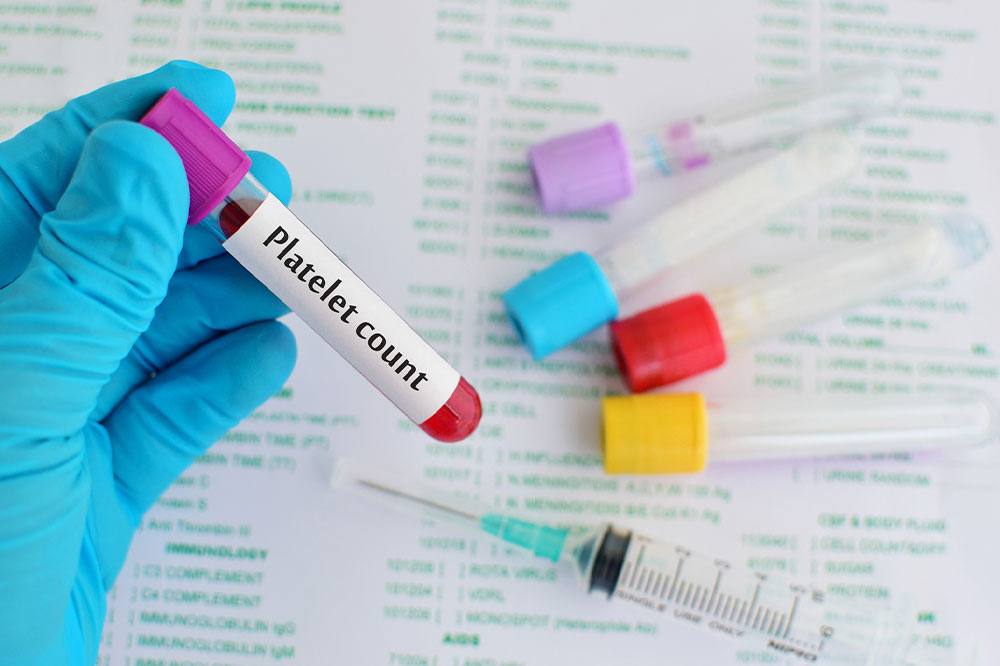Low Platelet Count – Ways to Manage the Condition
If a person has low blood platelet levels, they suffer from a condition known as thrombocytopenia. Platelets are essential since they help the blood clot and stop excess bleeding. If a person’s platelet counts are low, they can bleed heavily and bruise easily. Thrombocytopenia can occur as a symptom of specific cancers or autoimmune diseases, or they can occur due to cancer treatments. This article sheds light on the condition, its diagnosis, and treatment options.
About thrombocytopenia
Thrombocytopenia occurs when a person’s blood platelet counts fall to an extremely low level. The name is derived from thrombocytes, which is another name for platelets.

The soft, spongy tissue inside bones called bone marrow is where all blood cells, including platelets, are created. A blood clot cannot form in people with thrombocytopenia because they lack sufficient platelets. If a thrombocytopenia patient suffers a cut or another injury, they could bleed excessively and be unable to stop it. Thrombocytopenia can be classified into these three types:
- Destruction of platelets: This is caused by an auto-antibody that combines with the platelet surface.
- Platelet sequestration: This can occur in people with liver illness or a big spleen.
Diagnosis
The doctor may take the following action if a person has thrombocytopenia or experiences other bleeding symptoms that are difficult to stop:
1. Physical examination
The doctor will assess the person’s medical and family history. They will have to explain if they are taking any type of treatment option. The doctor will look for bruises, rashes, and check for an enlarged liver or spleen.
2. Blood count
A complete blood count (CBC) measures the number of platelets, white blood cells, and red blood cells in the body.
3. Blood clot test
A blood clot test evaluates how long it takes for blood to clot. These tests include the prothrombin time and partial thromboplastin time.
Treatment options for thrombocytopenia
Thrombocytopenia’s severity and the cause will determine how it is treated. The major focus of low platelet treatment is to stop bleeding-related mortality and disability. If the problem is minor, treatment might not even be necessary. A normal platelet count is not required to stop bleeding, even with serious cuts or accidents. When the underlying cause of thrombocytopenia is addressed, it frequently gets better.
The doctor might recommend a different type of treatment if an adverse reaction is the root cause of low platelet count. After stopping the initial treatment, the majority of patients recover. A person might require additional treatment options to stop blood clotting. The doctor will determine if a person’s immune system is the reason for their low platelet count. If the immune system is responsible, a treatment option to suppress the immune system may be recommended.
A person might not need therapy if a low platelet count isn’t seriously interfering with their daily routines. Treatment of the underlying reason frequently allows doctors to increase platelet levels. This strategy can include various remedies.
Other therapies
- Transfusion of blood to momentarily raise a person’s blood platelet count. Platelets can be transfused only when the platelet count is critically low. (Transfused platelets circulate in the bloodstream for only around three days.)
- Splenectomy, or spleen removal
- Immunoglobulins (antibody proteins) and other options to increase platelet synthesis and decrease platelet deterioration.
- In severe thrombocytopenia cases, the doctor might recommend various treatment options, blood or platelet transfusions, or splenectomy.
Treatment options
The doctor may recommend a treatment option to increase platelet count. This can help increase the blood platelet count by slowing down the destruction of platelets. The treatment option allows many platelets to stay within the bloodstream, thus increasing the platelet count.
1. Platelet or blood transfusions
People who are actively bleeding or have a significant risk of bleeding are treated with blood or platelet transfusions. An intravenous (IV) tube is inserted into an artery using a needle. A person gets platelets or healthy blood through this tube.
2. Splenectomy
Surgery to remove the spleen is known as a splenectomy. When a person suffers from thrombocytopenia, their immune system considers blood platelets as foreign objects and destroys them. Since the spleen is responsible for getting rid of these platelets, removing it can help in circulating more platelets in the body. This type of surgery might be used if other treatments are ineffective. But using treatment options is usually recommended first.
In some instances, severe cases of thrombocytopenia can lead to internal and external bleeding. One should maintain caution so that they do not develop complications. If a person is at risk for developing this condition, they should avoid taking blood thinners. They should also be careful to not overindulge in contact sports or activities that can cause bruising and bleeding.


